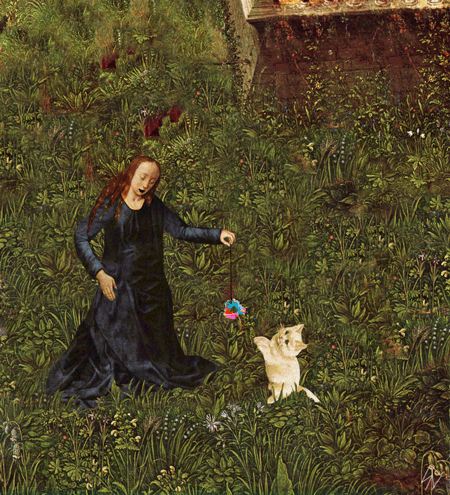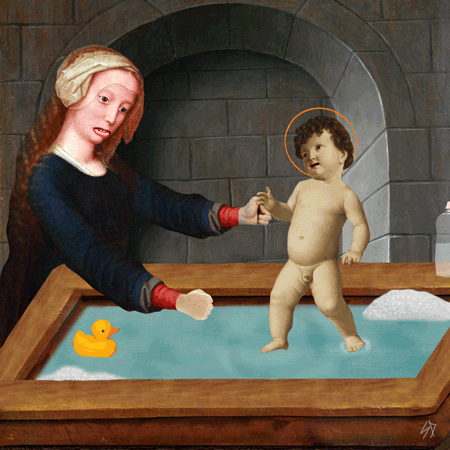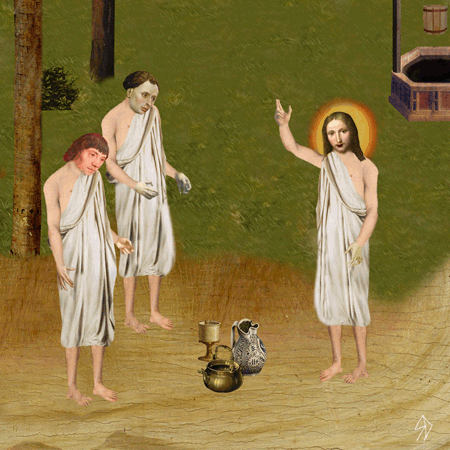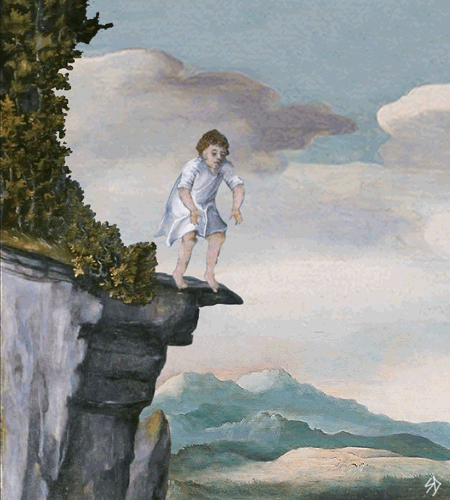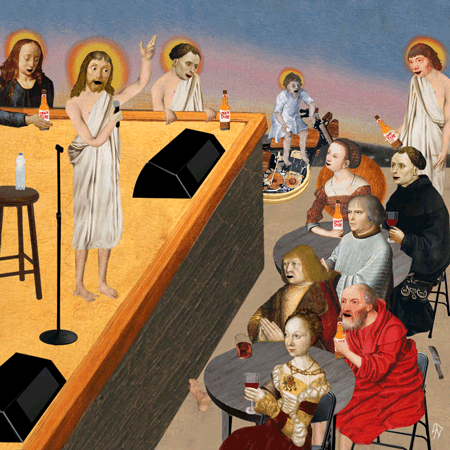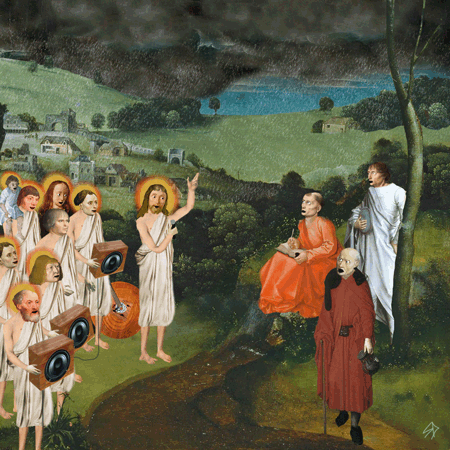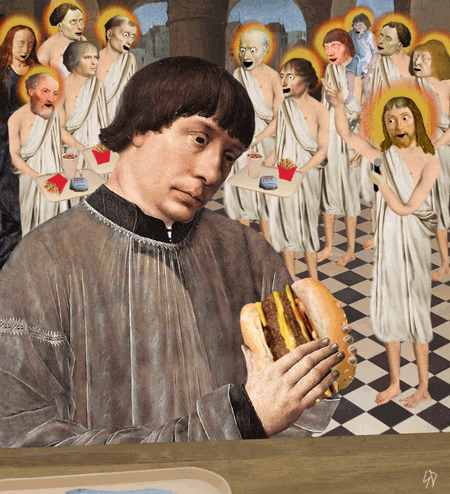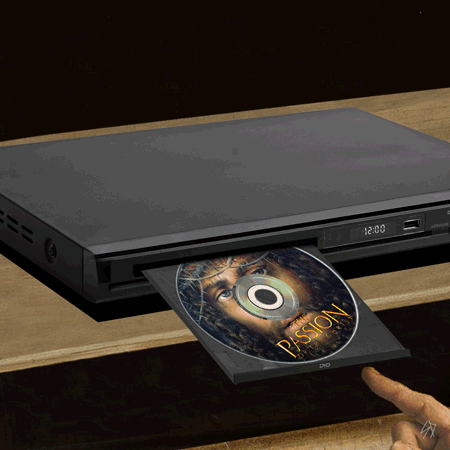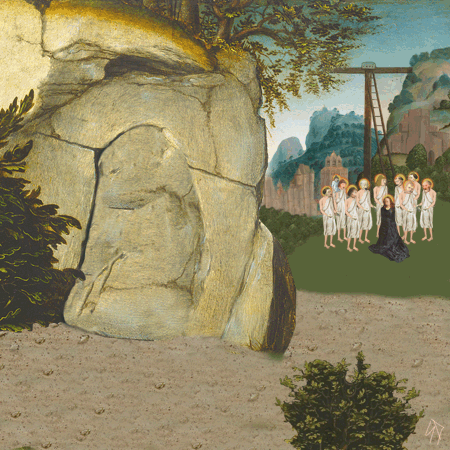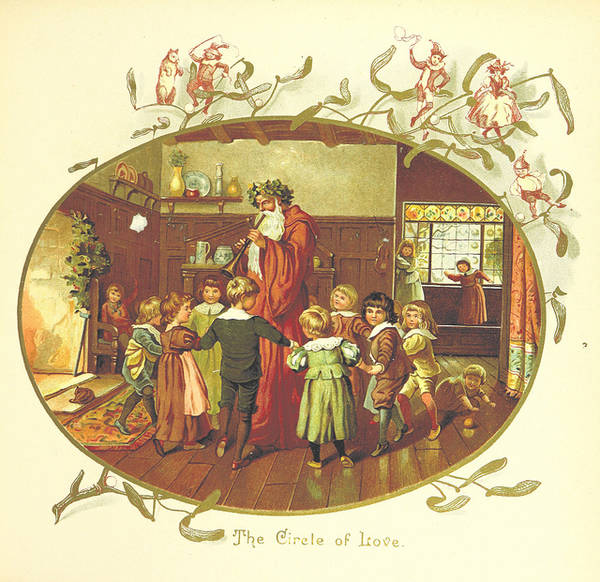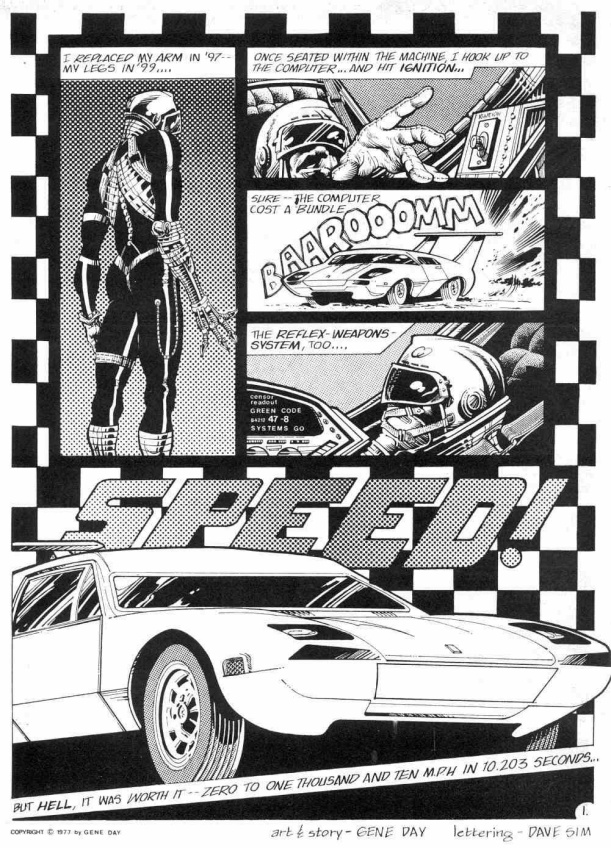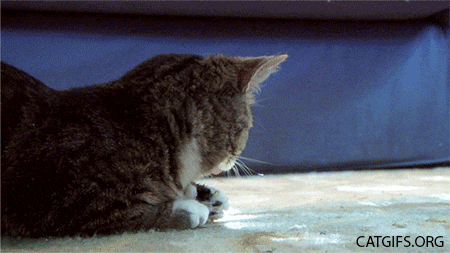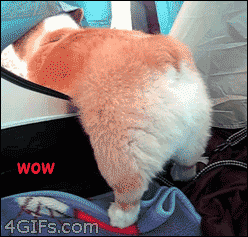From The Comics Journal #127 (March 1989), and conducted by Richard Samuel West.
Calvin and Hobbes is America’s hottest comic strip. After less than three years in syndication, it appears in more than 600 newspapers. The three Calvin and Hobbes collections are permanent fixtures on The New York Times best-seller list. And its creator, Bill Watterson, has already won the coveted National Cartoonist Society Cartoonist of the Year award.

So why haven’t you seen the Calvin and Hobbes characters splattered across the American landscape on burger glasses, greeting cards, and as stuffed toys? Because Watterson says “No” to licensing. In fact, Watterson probably says “No” more than Calvin’s prank-weary parents. Frankly, he’s not interested in it, and he tells us why in this interview. Watterson was born in Washington, D.C., 1958. At Chagrin Falls High School and Kenyon College in Ohio, he drew for the student newspapers and yearbooks. Upon graduation in 1980, he became the political cartoonist for The Cincinnati Post, an experience he remembers as relentlessly depressing but mercifully short. Unable to fulfill his editor’s fuzzy notion of what an editorial cartoon should be, Watterson was fired before the end of his first year. For the next five years, Watterson submitted comic strip ideas to the syndicates. Six were developed; six were rejected. United Features Syndicate was the most encouraging, and Watterson’s seventh development contract, this one with UFS, resulted in Calvin and Hobbes. Ironically, UFS declined to distribute it, saying they didn’t think it would sell. Universal Press Syndicate snatched it up and launched it on November 1985. Watterson values his privacy and only rarely gives interviews. He agreed to do this one on the grounds that the strip be the center of discussion. The interview was conducted, transcribed, and edited by Richard West, editor of the late and lamented political cartoon journal Target, and longtime friend of Watterson.
All images by and ©Bill Watterson.
RICHARD WEST: How do you explain the popularity of Calvin and Hobbes?
BILL WATTERSON: Really, I don’t understand it, since I never set out to make Calvin and Hobbes a popular strip. I just draw it for myself. I guess I have a gift for expressing pedestrian tastes. In a way, it’s kind of depressing.
WEST: Isn’t it ironic that in a profession that’s become so formulaic you have created the most successful comic strip of the ’80s by not trying to fulfill a formula?
WATTERSON: But in a way, I’ve ended up with the old tried and true. It’s a strip about a family — a familiar, universal setting that’s easy to identify with. I’m trying to put a unique twist on it, but it’s well-covered ground. The trend nowadays in comics seems to be to zero in on a narrow, specific audience, like divorced parents, baby boomers, and so on. I guess the idea is to attract a devoted special interest group to the comic page who will scream if the strip is ever dropped. That way, the strip stands a better chance of survival than a strip that aims wide but doesn’t hit deep. Generally, I don’t like these trend-of- the-month strips because they’re usually the product of some market analysis rather than the product of any honest artistic sensibility on the part of the cartoonist. Still, with any strip, it’s not the subject that’s important: it’s what you do with it. A family strip can be hackneyed drivel just as easily as any other kind of strip.
WEST: Sometimes Calvin acts very childlike and at other times he acts and says things that are completely impossible for a child of 6. What are your thoughts on that?
WATTERSON: The main concern for me is flexibility — what’s going to give me the most range, what voice is going to give me the most leverage. As far as making the kid into a wisecracking adult, that’s certainly been the approach of a lot of comics. The appeal of that is that, you know, the cartoonist is an adult and, presumably, he has adult comments to make. It’s not natural to speak through the mind of a child.
WEST: The whole joke rests on putting sophisticated thoughts into the mouth of a baby or child.
WATTERSON: Right. What I have enjoyed about Calvin is that I feel I’ve got the range to do what I want, that he can be childish at some points and not at others. The whole challenge really is to set up rules. You can make your cartoon world have as much sense or as little sense as you want to, and the main thing is that you’re consistent within that vision. I think the audience will go along with you. It doesn’t have to be one or the other.
One of the neat things about Bloom County is that the strip has virtually no rules at all. Cutter John rides a wheelchair loaded with animals wearing fish bowls for space helmets, and that’s just the way things are. Everyone in the strip accepts it, and we readers do, too. In essence, Breathed says he’s going to draw whatever he feels like, and he’s not going to worry about a lot of clever explanations for what happens. The readers have to take it or leave it. It’s a riskier way to write, but it gives Breathed complete freedom in the world he’s set up. Other strips, equally good, have more ordered universes. I suppose mine is somewhere in between the extremes.
WEST: Do you think that because Breathed has established no rules, he limits the acceptability of his strip? Or, put another way, because Calvin and Hobbes is restricted in some ways — that you are respecting the boundaries that you have created in this fantasy world — that it’s easier for people to accept the strip, and that explains some of its popularity?
WATTERSON: That’s possible. That aspect of it doesn’t interest me much. Who reads it and who doesn’t isn’t a concern of mine.
WEST: I’m talking about acceptability. For instance, if you violated the rules of Calvin’s fantasy world, how would that diminish the strip? Why couldn’t you have less rules? Why couldn’t the strip be more like Bloom County?
WATTERSON: I think it’s the way I’m most comfortable writing. I like to work within certain confines. The aspect of the strip that I have the most fun playing with is the personalities and the characters. In other words, their interaction is what is interesting to me, not the playing with the form of the comic strip. I’ll qualify that. Visually, I like to play with the form, but, for example, Bloom County occasionally has a narrator. It’s a wonderful device, but it doesn’t really fit my needs. What I’m trying to do in Calvin and Hobbes is make it realistic enough so that I can explore the ideas that interest me without making it so realistic that it confines me.
WEST: You once said that Calvin’s imagination was greater than yours. Where do you go to find inspiration if you’re not basing it on your world?
WATTERSON: Well, for example, just a simple thing that I’ve played around with a couple of times is the issue of size. You take your size for granted. You get larger up to a point and then you stop, and then that is your size, and you relate to the world from that viewpoint. If size was a complete variable, what would the world be like? In other words, if there was not a hard and fast rule of growth, how would things change? That presents me with an awful lot of visual possibilities that I enjoy working with. And to adults who are used to thinking of the world from a certain vantage point, it sometimes seems fresh, I hope.
WEST: One of the best things about the strip is that you surprise readers with the areas of concern of the strip. Do you surprise yourself? Do you find yourself pursuing things that delight you: that you’ve stumbled upon? Is the inspiration on automatic pilot?
WATTERSON: I wish it was more than it actually is. I can’t just turn off the things that we all accept or have learned. For example, everybody works with a day-to-day assumption that gravity is going to be there from the time he gets up until he goes to bed and so on. To imagine if gravity were suddenly turned off requires an effort. My mind doesn’t just naturally go off in these odd directions all the time.
WEST: Well, in the last three years, have the fantasy sequences gotten easier? You seem to be doing less of them these days. Is there a reason?

WATTERSON: At first it was fun simply to juxtapose fantasy with reality — the simple fact that the reader could see the fantasy and then, at the end, see the flip. See it from the child’s view and then, later, see it from the adult view and realize that there’s an inconsistency there. That was originally a fun device, but the burden on the strip has been to make each switch more clever. The juxtaposition alone can get predictable if it’s just done over and over in the same way. Each time it’s got to be done with some unpredictability: some cleverness to it so that it doesn’t become moribund. So, yes, I’m doing fewer because it’s getting more and more difficult. But I still try to do the fantasies as they interest me. There’s a limitation to them. They’re fun to read and they’re certainly fun to draw, but they don’t have the emotional weight to them that an interaction between two interesting characters does. In other words, when Spiff is on Planet Zorg, it’s a visual feast. I get to draw bizarre landscapes and monsters and fool with lighting and color and so on, in the Sundays. It’s an adventure story on the simplest level. He reacts to the situation and then maybe at the end it flips into a classroom or whatever, but there’s no emotional depth. The depth of the friendship between Calvin and Hobbes interests me because of its significance. Each kind of story has its own problems in writing, but my main concern really is to keep the reader on his toes, or to keep the strip unpredictable. I try to achieve some sort of balance between the two that keeps the reader wondering what’s going to happen next and be surprised.
WEST: What do you say to the thought that Calvin and Hobbes is basically the exploration of a friendship and that all of the other comic devices you use are comic relief from that emotional center?
WATTERSON: That’s not far off, but I don’t know if I’d say the other is just a relief from that. Both interest me for different reasons. Really, what I’m trying to do is to juggle as many balls as I can at once so that I’ll have a slapstick joke one day, a fantasy another day, a friendship, a sadness. I try to explore as diverse a world as I’m capable of. This, again, gives me the flexibility to keep the writing interesting and I hope it also keeps it lively for the reader as well.
WEST: Let’s talk about Hobbes a little bit. He seems to be older and wiser than Calvin, but not much. Which of the following more accurately describes him: a pet, a brother, a friend, or the father that Calvin never had?
WATTERSON: Hobbes is really hard to define and, in a way, I’m reluctant to do it. I think there’s an aspect of this character that’s hard for me to articulate. I suppose if I had to choose from those four, the brother and the friend would be the closest. But there’s something a little peculiar about him that’s, hopefully, not readily categorized.
WEST: Well, in a way that says more about Calvin than Hobbes because Hobbes is implicitly, explicitly just a product of his imagination.
WATTERSON: But the strip doesn’t assert that. That’s the assumption that adults make because nobody else sees him, sees Hobbes, in the way that Calvin does. Some reporter was writing a story on imaginary friends and they asked me for a comment, and I didn’t do it because I really have absolutely no knowledge about imaginary friends. It would seem to me, though, that when you make up a friend for yourself, you would have somebody to agree with you, not to argue with you. So Hobbes is more real than I suspect any kid would dream up.
WEST: Well, at the risk of getting into psychobabble, a lot of psychologists would say that children create imaginary friends to play out family dramas. So an argument can be just as much a part of an imaginary world as, you know, a sort of sentimental, gooey friendship can be.
WATTERSON: Yeah, well, I would hope that the friendship between Calvin and Hobbes is so complex that it would transcend a normal fantasy. The resolution of the question of whether Hobbes is real or not doesn’t concern me or interest me, but, hopefully, there’s some element of complexity there that will make the relationship interesting on a couple of levels.
WEST: So you’ve delineated a fine boundary that is pushed out of shape at various points and almost illogical at various points, but it has an internal consistency of sorts.
WATTERSON: Of sorts, yes.
WEST: You must find yourself in situations where you say, “No, I can’t do that,’’ and other times when you willingly violate what would seem to be a logical rule just for effect.
WATTERSON: Such as?
WEST: Well, such as when Hobbes tied Calvin up to a chair. If you accept the rest of the fantasy that you’ve created — that Hobbes is imaginary — that’s an impossibility.
WATTERSON: Yeah, and Calvin’s dad finds him tied up and the question remains, really, how did he get that way? His dad assumes that Calvin tied himself up somehow, so well that he couldn’t get out. Calvin explains that Hobbes did this to him and he tries to place the blame on Hobbes entirely, and it’s never resolved in the strip. Again I don’t think that’s just a cheap way out of the story. I like the tension that that creates, where you’ve got two versions of reality that do not mix. Something odd has happened and neither makes complete sense, so you’re left to make out of it what you want.

WEST: I guess that’s the rule of some of the best fantasies. Did Alice really go through the looking glass? Was Dorothy really in Oz? What do you choose to believe?
WATTERSON: I should also mention, just in that context, that the fantasy/reality question is a literary device, so the ultimate reality of it doesn’t really matter that much anyway. In other words, when Dorothy’s in Oz, if you want to make this obviously a dream, it becomes stupid — you confine yourself.
WEST: It has less purpose.
WATTERSON: And also less potential. There are inner workings in The Wizard of Oz that are too coherent for a dream — at least my dreams are never that coherent— and so it becomes less interesting if it is only a dream. The literary merits, the purpose of writing it that way, are better served by some ambiguity than by making everything very obvious.
WEST: You do a lot with the visuals of the strip. Do you make a conscious effort to vary the visual, as well as the storylines?
WATTERSON: I enjoy the drawing more than the writing, so I try to think of ideas that will allow me to develop the visual side of the strip as fully as possible. Some ideas don’t lend themselves to that. Even then, I try to make the drawings as interesting as I possibly can, given the very limited constraints of the format. In other words, if I’ve got essentially two characters talking in a daily, I’ll try to put them in an interesting location, have them walking through the woods. I’ll try different perspectives. If I’ve got several days’ strips that are essentially talking strips, one day I’ll eliminate all background, have it as sparse and clean as I can; the next day, try to make it a little lusher or develop the setting more. This is probably done more out of boredom than any conscious decision to do this one day and do this another day. The Sundays are the one day that I have a little more freedom with the visual aspects. The fun of a Sunday is that I have more space. Sunday strips lend themselves to longer conversations or visual things or, best of all, both: although if you have much conversation then you don’t have room for much visual. Sundays are more consciously chosen to reflect those two interests.
WEST: Isn’t there a remarkable similarity between Hobbes and Tigger?
WATTERSON: People have pointed that out. Tigger is probably more naive and energetic, but he’s an endearing character. Disney did a good job with him in animation, although the other Pooh characters suffered in the translation. The original Pooh stories are very subtle and sophisticated. They went right over my head as a kid, which is why they never were a real influence on me, but I reread them recently, and they’re hilarious. If I had understood the stories earlier, I’d have certainly swiped the idea.
WEST: Well, isn’t the point that there are similarities between characters that have appeared before in literature and you’d be the last one to say that a child with an imaginary animal friend sprang virginlike from your brain.
WATTERSON: Right. And many of the situations I deal with — monsters under the bed, these sorts of things — are well-worn themes. Hopefully, I’m doing something new with them or putting a different life into them just because it’s being filtered through my personality, but, yeah, I would never claim that nothing like this had ever been seen on the face of the earth before.
WEST: The parents are really an interesting part of the strip. In a way they’re foils, but the thing that interests me is that it’s extremely rare for them to express any love for Calvin. Is that simply because it doesn’t have any comic potential, or is it something inherent in their characters?
WATTERSON: Again, I feel like I’m falling into the trap of psychoanalyzing the characters and I don’t want to say, “Well, this character acts this way,” because that’s confining. I think the way they relate to Calvin is more a reflection of my misanthropic tendencies than any literary concern.
Many strips have, you know, the funny character, the straight man, the foil — those characters are stereotypes and fairly flat. The role of these characters in the strip is entirely defined by their function as a member of a social group or age group, or whatever, and I’m trying to avoid that as much as I possibly can. I try to make each character, even the ones that aren’t that important, a unique personality that, over time, will develop. Some of the minor characters appear less often than Calvin and Hobbes, but, hopefully, over years, each one will become a unique personality that will be every bit as complex and interesting as Calvin and Hobbes.
In other words, I don’t want the parents to simply function as parents. I want them to be unique individuals as well. They are parents, of course, and, as sane people, they have to react to Calvin’s personality. What I try to do in writing any character is to put myself in his position, to the extent that I can, and I know that if I was Calvin’s dad or Calvin’s mom that I would not react to him with the gooey sentimentality that sometimes appears in other strips. Given Calvin’s usual behavior, I think his parents show admirable restraint in theirs.
WEST: Is it easier for you to imagine being the father than it is to imagine being Calvin?
WATTERSON: The dad is, in some ways, a parody of my own dad and he’s also part of myself.
I’m also part of the mother, too, and Susie, and everyone else. I’m pulling out different aspects of my personality in writing each character and, if I’m doing my job well, I’m being true to the situation and true to the character. Hopefully, the mother is not just the disciplinarian, but is more well-rounded than that — the same thing with the father or Susie, and so on. My aim is to make each one complete and real.
WEST: You’ve resisted saying anything as simple as Calvin was you as a child.
WATTERSON: Well, Calvin’s not the way I actually behaved, but there’s a part of me that would behave that way if I had no concern at all for anyone else.
The socialization that we all go through to become adults teaches you not to say certain things because you later suffer the consequences. Calvin doesn’t know that rule of thumb yet.
WEST: Is there room in the strip for another child?
WATTERSON: I think that would jeopardize the relationship between Calvin and Hobbes.
WEST: And, considering Calvin’s personality, it might be totally unrealistic that the parents would want to have a second child.
WATTERSON: Yeah, well, that’s sort of the running joke through the whole thing: that Calvin is such an awful nuisance that they’re not eager to repeat that mistake.

In a way, it’s surprised me that the strip hasn’t exhausted its cast very much at all. The baby-sitter came after a few months but, really, aside from that, the strip has stayed the same as I originally planned it. Most strips grow when new characters are added periodically, and I expect to do that once in a while, but I think they will always be minor characters. I don’t expect to add a major character into the center of the strip. The strip’s world is a very small, insulated one, which, I think, is more natural to me.
What I found to be true of the earlier strips I developed was that I was often making my cast much greater than I had the authority to speak about. I was trying to deal with friendships and relationships that I don’t understand. With Calvin and Hobbes, I don’t really think of them as a comedy team that dances on stage and does an act for you. It’s a very natural and personal friendship of the type that I’m most familiar and comfortable with myself.
WEST: Well, talking about the evolution of the strip, almost everywhere you look in comic-strip annals, the star of the strip emerges well into the life of the strip. Pogo really began with Albert the Alligator as the star; Peanuts began with Charlie Brown as the star, now he’s second fiddle to Snoopy; even in Bloom County, Opus, who wasn’t even a part of the original cast, is now pretty much the center of the strip. Can that happen in Calvin and Hobbes?
WATTERSON: I don’t think so. In the first place, I feel comfortable with the way the cast works out. Calvin and Hobbes together are more than the sum of their parts. Each ticks because the other is around to share in the little conspiracies, or to argue and fight with. In many comic strips the animal eventually steals the show, just because animals offer more freedom to the cartoonist. As we were talking about earlier, the improbability of certain thoughts coming from the mouth of a child provides a kind of humor just from the context. Well, it’s even more the case with an animal because it’s even more improbable.
Also, there is more latitude that way. You know, you can draw a penguin on a toilet reading The New York Times and it’s adorable, but try doing it with an adult male character, and it’s disgusting. I think there is always the temptation to go with the most flexible and fun character, and that’s almost always the animal. With Calvin and Hobbes, though, Hobbes is the more subtle of the two while Calvin is the loud, obnoxious one. Each is funnier in contrast to the other than they would be by themselves. In fact, because Hobbes is the much more subtle and quiet character, it sometimes surprises me that people respond so warmly to him because I think his character is much harder to get a grasp on. It may just be because he’s cute.
WEST: Or a cat.

WATTERSON: Yeah, right. I don’t foresee the dynamic between them reversing itself or moving in wild directions. I hope to develop the dynamic and make it more subtle, more complex, but I don’t really see the direction of the strip moving in radical directions.
WEST: In looking at Krazy Kat, do you draw any strength from what Herriman did in terms of the relationships of his characters?
WATTERSON: Krazy Kat is a completely unique strip. I think it’s the best comic strip ever drawn. Ultimately, though, it’s such a peculiar and idiosyncratic vision that it has little to say to me directly. I marvel at it because it’s beyond duplication. It’s like trying to paint a sunrise — you’re better off not even trying. Peanuts and Pogo have been inspirations, too, but these strips are much more down to earth, and are much closer to my own way of thinking, and have had much more direct influence. Even so, I try to keep the instances of blatant plagiarism to a minimum. Looking back, you’ll see that some of the old strips are one-gag formulas, endlessly varied. Krazy Kat revolves around the tossing of the brick. Little Nemo was always a dream, and you know the kid is going to wake up in a heap at the bottom of his bed in every single strip. I find Herriman a lot more interesting than McCay, but both are working within a very limited construct. It’s a very different approach to cartooning that what we do now. I would go insane working with limited formulas like theirs, but on the other hand, Herriman and McCay gave us something better than gags. Back then, the fun was in the getting there. The destination of each strip was the same, but every day you went there by a different road. Today, we want the strip over as soon as possible — “Just hand me the punch line, please.” The fewer panels, words, and drawings, the better: I think Pogo was the last of the enjoy-the-ride strips. It’s a shame. We’ve really lost what comics do best.
WEST: Can’t you still do that with the Sundays?
WATTERSON: The Sundays are frustrating — you have to waste the entire top third of the strip so that the panels can be dropped or reconfigured for certain-sized newspapers. This really limits what I can do. Krazy Kat had a whole page to itself, as did Nemo. Even so, there’s more flexibility on Sundays than in the daily strips. I’ve always tried to make the strip animated, even when the characters aren’t moving, with expressions or perspectives or some sort of exaggeration. There’s great potential for that which has yet to be fully mined.
WEST: For you personally, or do you mean in the comics in general?
WATTERSON: For me personally, and for comics in general. I would love to take it much further, although, again, this is something where I feel limited by my imagination and abilities at times, but comics, with the shrinkage, have gone away from that. The visual aspect of comics is what got me into the profession in the first place. It seems ridiculous to not take advantage of that to the fullest extent you can. Animation is, I think, the fulfillment of the cartoon. There is nothing you cannot do in animation. Unfortunately, animation has not taken advantage of that either, and usually ends up with stupid stories or crude art. The whole cartoon industry has degenerated over the years. WEST: Well, if you can create the impression of an animated world in a comic strip, and I think it could be said that you’ve done that with a fair degree of success, what’s the point of doing animation?
WATTERSON: Animation is an art all its own. If you look at the old cartoons by Tex Avery and Chuck Jones, you’ll see that there are a lot of things single drawings just can’t do. Animators can get away with incredible distortion and exaggeration — for example, to show surprise, a character might turn into a giant eyeball for a fraction of a second — and the character can do this because the animator can control the length of time you see something. The bizarre exaggeration barely has time to register, and the viewer doesn’t ponder the incredible license he’s witnessed.
In a comic strip, you just show the highlights of action — you can’t show the buildup and release… or at least not without slowing down the pace of everything to the point where it’s like looking at individual frames of a movie, in which case you’ve probably lost the effect you were trying to achieve. In a comic strip, you can suggest motion and time, but it’s very crude compared to what an animator can do. I have a real awe for good animation.
WEST: Isn’t it a bit scary to think of hearing Calvin’s voice?
WATTERSON: Very scary. For all my admiration of the art, I really can’t decide if I ever want to see Calvin and Hobbes animated. I know I’d enjoy working with the visual opportunities animation offers, but you change the world you’ve created when you change the medium in which it’s presented. Books are almost always better than the movies made from them, because there are things books do well and things movies do well, but usually those things don’t overlap: the same with comics and animation.

Another, more personal reservation I have is that animation, by necessity, is a team sport, and the fewer people with input into my work, the better I like it. And, finally, to see it done right, it would also take an awful lot of time and energy on my part, neither of which I’ve got a lot to spare.
WEST: You’ve rejected licensing your strip’s characters. Why?
WATTERSON: Basically, I’ve decided that licensing is inconsistent with what I’m trying to do with Calvin and Hobbes. I take cartoons seriously as an art form, so I think with an issue like licensing, it’s important to analyze what my strip is about, and what makes it work. It’s easy to transfer the essence of a gag-oriented strip, especially a one-panel gag strip, from the newspaper page to a T-shirt, a mug, a greeting card, and so on. The joke reads the same no matter what it’s printed on, and the joke is what the strip is about. Nothing is lost. My strip works differently. Calvin and Hobbes isn’t a gag strip. It has a punch line, but the strip is about more than that. The humor is situational, and often episodic. It relies on conversation, and the development of personalities and relationships. These aren’t concerns you can wrap up neatly in a clever little saying for people to send each other or to hang up on their walls. To explore character, you need lots of time and space. Note pads and coffee mugs just aren’t appropriate vehicles for what I’m trying to do here. I’m not interested in removing all the subtlety from my work to condense it for a product. The strip is about more than jokes. I think the syndicate would admit this if they would start looking at my strip instead of just the royalty checks. Unfortunately, they are in the cartoon business only because it makes money, so arguments about artistic intentions are never very persuasive to them. I have no aversion to obscene wealth, but that’s not my motivation either. I think to license Calvin and Hobbes would ruin the most precious qualities of my strip and, once that happens, you can’t buy those qualities back.
WEST: Well, what about something like a doll? That’s not a product like a coffee mug, which would be there whether the strip characters were printed on it or not. Why doesn’t a doll fit into your definition of appropriate licensing?
WATTERSON: A doll communicates even less of the strip than the things mentioned before. A doll only cashes in on the recognizability of the character. Products like that take the character out of the world for which he was intended. If you stick 30 Hobbes dolls on a drugstore shelf, you’re no longer talking about a character I created. At that point, you’ve transformed him into just another overpriced knickknack. I have no interest in turning my characters into commodities. If I’d wanted to sell plush garbage, I’d have gone to work as a carny. The idea of a Hobbes doll is especially noxious, because the whole intrigue of Hobbes is that he may or may not be a real tiger. The strip deliberately sets up two versions of reality without committing itself to either one. If I’m not going to answer the question of who or what Hobbes is, I’m certainly not going to let Dakin answer it. It makes no sense to allow someone to make Hobbes into a stuffed toy for real, and deprive the strip of an element of its magic.
WEST: I’m sure some of the readers will say to all this, “Come on. The comic strip is a popular art form.”
What’s wrong with indulging the public’s interest?
WATTERSON: Nothing, so long as it doesn’t compromise the art itself. In my case, I’m convinced that licensing would sell out the soul of Calvin and Hobbes. The world of a comic strip is much more fragile than most people realize. Once you’ve given up its integrity, that’s it. I want to make sure that never happens. Instead of asking what’s wrong with rampant commercialism, we ought to be asking, “What justifies it?”
Popular art does not have to pander to the lowest level of intelligence and taste.

WEST: Snoopy is selling insurance; Garfield is on everything from cereal boxes to car window visors. How do you feel about what your colleagues are doing?
WATTERSON: I would probably have done things differently than other cartoonists have, but other people’s strips aren’t my job. As I said, some strips lend themselves to certain merchandising projects better than others. I’m not condemning licensing across the board; I’m saying licensing doesn’t work for Calvin and Hobbes, and I want the freedom to do with the strip as I see fit.
Obviously, some cartoonists see things differently than I do, and that’s their right. My concern is that I be afforded the right to refuse licensing if I feel it hurts my strip. I think it is wrong that a syndicate should own characters it had no hand in creating, and that a syndicate should use that ownership to thwart the intentions of the cartoonist who did create the characters.
WEST: Aside from aesthetic questions, what happens to a strip when its characters become ubiquitous?
WATTERSON: Well, the obvious risk is satiating the interest. I think people can only stand so much of seeing the character around and I think that, after a while, resentment builds.
WEST: What can you envision as suitable licensing for Calvin and Hobbes? Nothing?
WATTERSON: I can’t think of a thing. I’m reserving judgment on animation. Calvin and Hobbes was designed as a comic strip and I’ve found nothing that presents my comic strip as well as newspapers and books. Actually, books do the best job of all. Books show the work as a body, in sequence, on better paper and at a larger size than the newspapers run it. Books are also more permanent, which is essential to the growth of comic strip art. Walt Kelly died a few years after I discovered Pogo and if it weren’t for the Pogo books I’d have been deprived of a great influence. The same goes for Krazy Kat. New cartoonists don’t have to reinvent the wheel. They can build on others’ accomplishments. Books allow cartoons to live longer and that’s a real service.
WEST: You mention size. What’s all the fuss about the size of comic strips?
WATTERSON: The size issue is crucial to anyone who cares about quality in cartoons. To save space, newsprint, and money, newspapers have been reducing the size of comics for years. It has gotten to the point now, where cartoons can no longer do what they do best. Comic strips are words and pictures, but there is little room for either any more. Most cartoonists, to make their work legible at tiny reproduction, have eliminated panels, line-work, and words, and the result is a drastic loss in character development, storytelling ability, and intelligent humor. A beautiful strip like Pogo would be impossible to read at today’s sizes. Adventure strips are dead. Comics have been deprived of much of their ability to entertain. Now we have a lot of talking heads and gags that could be read with equal effect on the radio.
The visual attraction of the comics is largely a thing of the past. Until something is done to restore the size of comics, they will only continue to get more insipid, and have less pull on their audiences. To save a few inches of space, newspapers are killing the appeal of comics. Unfortunately, the syndicates and cartoonists are afraid newspapers would drop strips rather than add space if cartoons were printed larger, so few are willing to take a stand on this issue. Nobody wants to lose his strip over a few little picas.
WEST: When you look at the comics today, whose work excites you?
WATTERSON: Doonesbury, of course, has had a tremendous impact and influence on comics, and I greatly admire Trudeau’s work. He is probably the best writer in the field today. He can handle virtually anything — tragedy, social commentary, personal relationships, you name it — with sensitivity, intelligence, and devastating wit. He has shown that comics are not solely the domain of prepubescents. Lately, Trudeau’s artwork has become quite daring and inventive as well.
I enjoy Bloom County’s unpredictability and irreverence. In a generally brain-dead comics page, I usually find Bloom County’s to-hell-with-everybody anarchy refreshing. Opus, of course, is an inspired character.
Peanuts is long overdue for a serious reappraisal. Its ubiquitous licensing program unfortunately obscures what a well-crafted, beautifully written and drawn strip it is. Peanuts is one of the very rare strips with true heart. The sophistication and subtlety of the work is unbelievable. Comics don’t come better than this.
For Better or For Worse is very interesting to me because of its realism. I can think of no comic that has treated common, everyday domestic life with less artifice and stereotyping. I am impressed with the strip’s perception, honesty, and directness. It is also nicely drawn. The Far Side is another great one. I laugh out loud at this strip more than any other. The drawings somehow suit it exactly. Wonderful stuff.
Cathy is visually gray, but it’s cleverly written and it has a level of honesty to it that you don’t often see on the comics pages. After these, you have to reach pretty far into the barrel.
WEST: You’re excited by some of the early German expressionists, like Egon Schiele in particular. How does that affect how you approach the graphic challenges of Calvin and Hobbes?
WATTERSON: I try to look at a lot of different kinds of art. I enjoy the work of the German expressionists, particularly the woodcuts of the Bruecke group and Lyonel Feininger. Egon Schiele is also a favorite. I find all of his work very immediate and honest, and I suppose I respond most to the directness and rawness of these images. Prints of almost any kind have a special appeal to me. The physical difficulty in making an image usually seems to distill it, and the artist is less able to hide behind a lot of fancy technique. I like watercolor for the same reason. Once it’s down, you’re stuck with it. As to what influence these and other artists have on my cartoons, I’m hard pressed to say. Mainly they help me realize the many different ways one can visually express oneself. Too often cartoonists just look at other cartoonists and, after a lot of inbreeding, everyone has the same funny look. The challenge of drawing is that there is no one right way to visually describe something. It’s a good thing to confront your limitations and preconceptions every so often.
WEST: You work in acrylic, you do watercolors, you do some block prints…
WATTERSON: Those are just personal outlets and probably half of it is trying to learn the technical skills. I’m not a fine artist who has come to cartooning. I drew cartoons all my life and never learned how to really draw until fairly recently, so I’m still in the process of mastering technique and learning to work with color and that kind of thing. I find it very exciting because it’s all new, but it’s also frustrating because I’m not good at it. And, also, I enjoy the completely different approach to art where you don’t have to worry about writing at the same time.
WEST: Are they different or greater challenges than the comic strip?
WATTERSON: Probably different. There’s sort of a different thought process that goes into it, but I don’t know if you can really compare them. They all feed into each other: the cartoons feed into the painting and whatnot, and the paintings feed into the cartoons.
WEST: Kind of like toning the drawing muscle, exploring certain means of expression through other avenues…
WATTERSON: Or like vocabulary. The more words you have at your disposal, the more precisely you can express yourself.

WEST: Before Calvin and Hobbes, you submitted four or five comic strips to the syndicates, the later ones being kind of training grounds for Calvin and Hobbes. How do you look back on that time?
WATTERSON: When I was sending the strips out, I looked no farther forward than getting interest from the syndicate, so in drawing up three weeks’ or four weeks’ material I would hope to show enough versatility and enough basic competence in writing and drawing skills that would interest them. But I lacked foresight in thinking about the depth of the characters and whether they would actually be able not only to continue but expand as they went on. I think that’s probably the mistake that many would-be cartoonists make, that their characters are vehicles for gags, rather than distinct personalities that can grow and develop over the years. It was a learning process. You can’t learn to stand up and walk without falling down a lot, so it’s very fortunate that I was able to do that without anybody seeing these strips except friends.
WEST: Well, one thing that you didn’t do out of the public spotlight was editorial cartoons, professionally, for six months, with The Cincinnati Post. How do you think back on that experience?
WATTERSON: The experience itself was horrible, but getting fired forced me to reexamine how committed I was to political cartooning, and I finally admitted to myself that it had always been very difficult for me. I was never really very good at it.
WEST: You grew up in northern Ohio, and spent most of your life in that part of the world. Wouldn’t it be accurate to say that Calvin and Hobbes live in a northern-Ohio-like world?
WATTERSON: Yeah. It’s a Midwestern strip. I think I have Midwestern sensibilities, and I think the strip clearly reflects that. I’m comfortable with that aspect of it, especially from the standpoint that it would ring false if I tried to do something else.

![]()





























































































































































































































